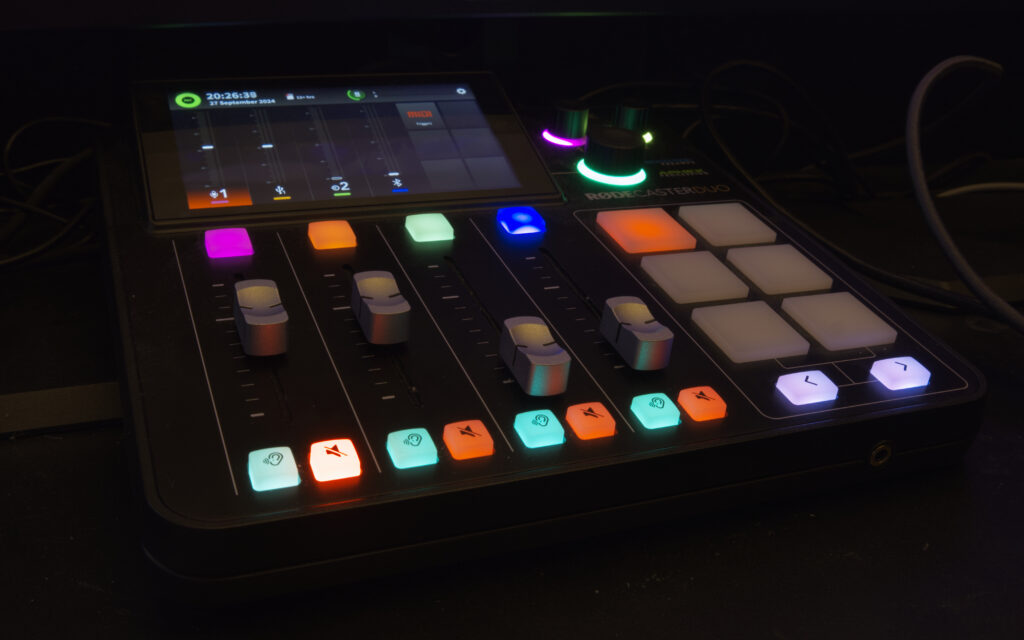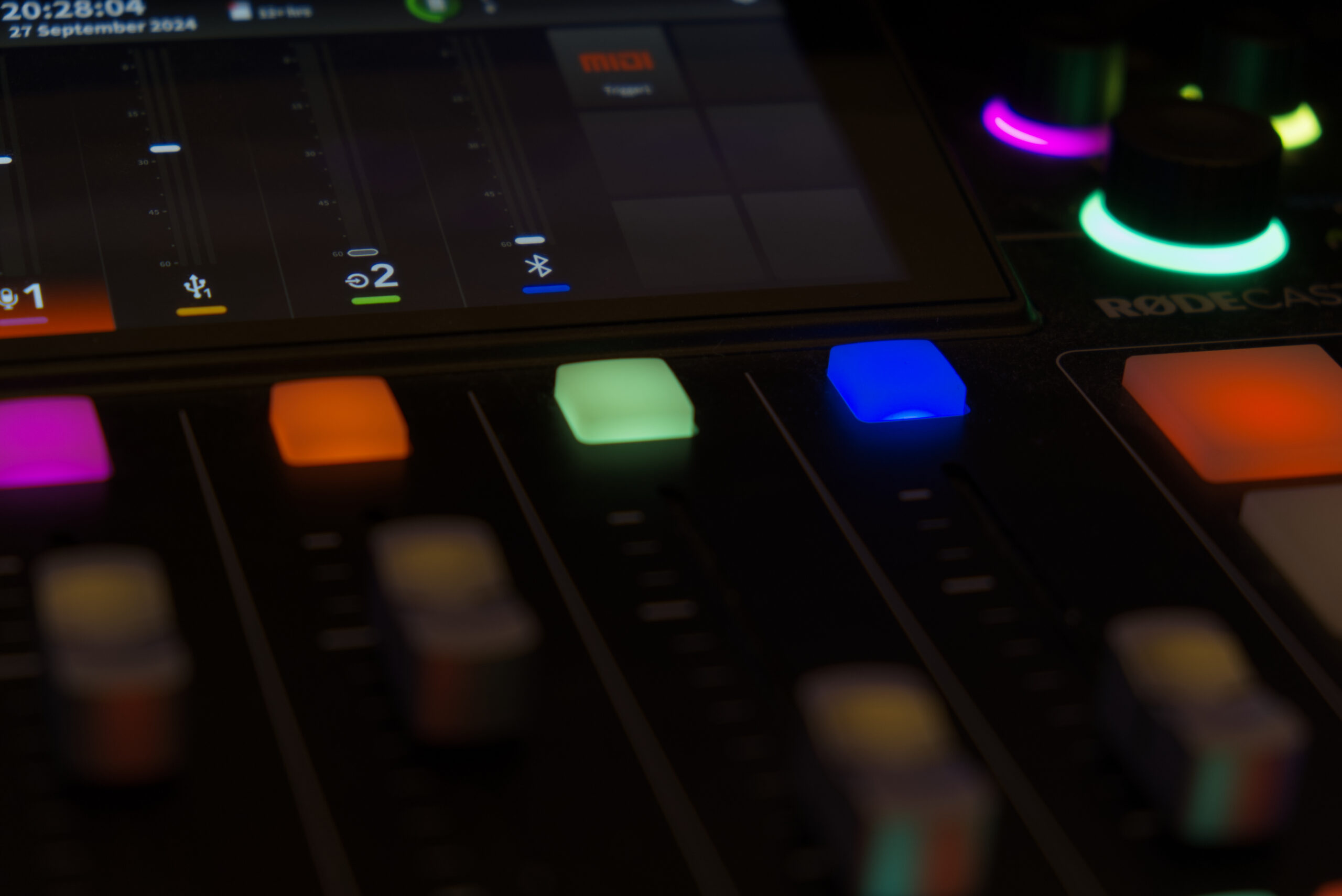I do a lot of Zoom calls. Because I don’t like having a mic right in front of me, limiting my freedom of movement or obscuring my line of sight to the screens at my desk, I use a shotgun mic that is mounted about 3ft /1m from my normal head position. I needed an audio interface that allows me to configure some basic mic effects for this. I also wanted to have some more controls and configurability for my audio setup. So this is not an overall review, but a review for my specific use-cases.
I bought the device a year ago at Sweetwater for $460.
Here were my requirements for upgrading from a third-gen Focusrite Scarlett Solo 3:
- Effects to improve mic sound that can be configured in-device so I can switch between different computers for work/personal use.
- A separate headphone volume control (to be fair, this was added to the 4th-gen Focusrite Scarlett Solo.)
- A dedicated Mic mute button.
And then there were a few bonus “nice to have” features.
- The ability to send input from multiple devices/computers to my speakers.
- The ability to connect my phone via bluetooth as an input/’hands-free”.
… and that’s what my Rødecaster Duo is for!
The Rødecaster Duo is essentially a little all-in-one recording studio, minus the mic and monitors of course. I know it can do much more like in-device recoding and all sorts of funny voice effects, but I don’t really need that and I’ll focus on what it does for me, being more of a audio interface “plus”.
I use my Rødecaster Duo with:
- 2 KRK Rokit 5 G4 monitors
- A Røde NGT-1 Mic
- 2 computers
- 2019 Intel Mac Pro
- M2 Max 14″ MacBook Pro
The Rødecaster Duo can be configured entirely in-device, but it’s also possible to use the Røde Central App to configure the same things.
First of all, I do appreciate that, to the computer, it is just an audio interface. No additional software is required. The mute button for a channel actually mutes that channel in the device. That’s just perfect. That’s different from, say, using a MIDI controller and then a traditional audio interface. You’d need to configure your software to react to the input from the MIDI controller. But since everything in the Rødecaster Duo happens in device, I don’t have to do that.

Everyday usage
The device works great for Zoom calls and such. I also use the extra 3.5mm TRS input for a dev board or other sources. This way, I can mix audio from two sources (my workstation and a devboard) and I even have faders for it! For each channel, I can configure what goes into the mix, so I can, for example, decide whether audio coming in from the second channel should be audible to people in my Zoom call or only through my speakers. In addition to the 4 hardware channels with actual faders, the device supports another 3 “virtual” channels that can be operated through the touchscreen. All channels can be configured to be mixed into all other channels, but the device is smart enough to default to a “mix minus” option, to prevent feedback loops.
I don’t have the right equipment here to measure the quality of the amps. it sounds just as good as the Focusrite to me.
Since I don’t want the device to be running all night, I usually shut it down at the end of the day. (It generates quite some heat!) It takes a while to start up and shut down. While the shutdown is fine, the startup gets annoying, if I want to hop in a quick call. Startup time I measured around 30 seconds at first. It got a few seconds shorter with an update, but it’s something to be aware of.
I do have a 64GB SD card in the device, but I rarely use it (only to sometimes record calls from my iPhone connected via bluetooth.). The whole Bluetooth thing is great. This way I can also have a call on my phone “join” a Zoom call on my computer. It also lets me use it as a “hands-free” for my phone when I do calls, so I don’t even need my computer up and running for that (say, I can join zoom calls via my phone while my computer is rebooting to install updates).
Reliability
The device runs pretty stable. Usually I get through the work week without a hiccup. Every few months or so, it will just crash/freeze and I’ll need to unplug and re-plug the USB-C power. I noticed there is also a rare freeze that happened one time where it corrupted the SD card and wouldn’t boot anymore with that SD card inserted. (formatting the card on my computer fixed it).
Other than that, I’ve had the device for a year and it works fine and as expected. Once set up, it just sits there, quietly doing its job of being an audio interface on steroids.
Advanced Configuration
Unfortunately, I was a bit disappointed with the limited configuration options.
Being in a lot of Zoom calls, with attendees using very inconsistent mics (and Zoom not adjusting that), I’d love to have the option to put a limiter on my monitor audio. I can’t. There are compressors, noise gates, EQs, robot voices… but no simple Limiter.
It is possible to enable MIDI pass-through for the device to show up as a MIDI controller. But I cannot choose which of the controls should be passed on. It’s either all or nothing. This leads to a situation where a fader that I use on the device for my monitor volume is also recognized as a fader by say, Logic Pro by default. Software might then map controls (like the the volume of a virtual audio track) to that fader from the Rødecaster Duo. I can’t just use one fader in Logic Pro (without removing the default mapping) The same fader will then control two things, resulting in chaos. It is, however, possible to map MIDI-output to the buttons on the right independently. That’s good.
Also, why can’t I use one of those larger buttons as a mute-toggle for one of the audio channels? I’d love a larger “mic muted” button that glows blue when on and red when muted. The hardware certainly has this capability, but the software doesn’t give me the option. I can only use the small buttons at the bottom as mute buttons.
The “effects”-buttons I didn’t find very useful. The device is made with live streamers and podcasters in mind who like to add “quack” sounds or whatever to their streams. I don’t do that.
And even when I tried, I realized that the button sounds are a single channel that is either mixed into another channel or it’s not. But I can’t configure, say, one button to play a sound for everyone, and another button to play a sound just for myself. Really, I wish the thing just had an API, so I could for example, control the lights in my office, or switch a smart power switch on and off.
The small screen just sits there, glowing 99.99% of the time, showing virtual faders that represent the exact same state that my physical faders have. It’s not very useful information and I feel like the screen wouldn’t even be necessary, given that the device can also be configured via your computer. (I do admit, though, the screen makes the device completely independent as a little recording studio. I just wish it was possible to turn the screen off.)
All of these are things that could be added in a software Update (or that I could add myself if there was an SDK for creating my own effects or functions).
But updates are really slow.
Since version 1.3.4 (January 2024), there was no new firmware release. Røde might be starting to pick it up again, with a new beta release (1.4.3) that just came out a week ago.
+
- Compact, nifty controls
- It just works as a standard audio interface. (No crapware required!)
- Built-in effects that work across different host computers
–
- No automatic sleep or way to turn off display
- Slow boot and shutdown
- Feels a little wobbly for the price
- Limited configuration options
- No SDK

Leave a Reply